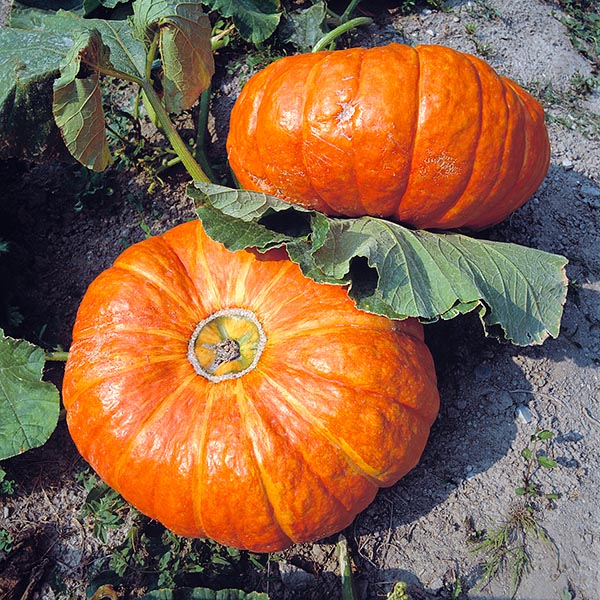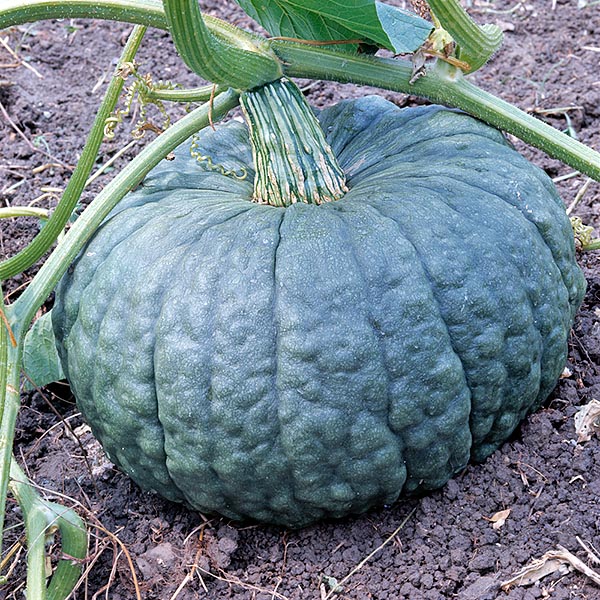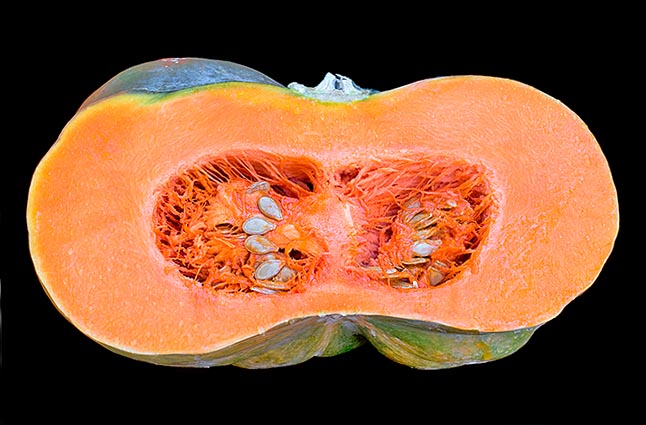Family : Cucurbitaceae

Text © Eugenio Zanotti

English translation by Mario Beltramini

Cucurbita maxima is an annual strong herbaceous plant native to tropical America © Giuseppe Mazza
The name of the genus “cucurbita” means in Latin squash; the specific one “maxima” means, always in Latin, maximum, the biggest, due to the size reached by the fruits.
It is a vigorous and big annual herbaceous plant, with procumbent or climbing stems, hollow, up to 6-8 metres long, ramose, wrinkled-angular, and bristly-prickly, with ramified cirri.
Alternate leaves, very big, rough but tender and fragile, of a nice green colour, often speckled of ashy pale green in the median part, with protruding nervations on the reverse, sub-cordate, palmate-lobed, with 3-7 lobes more or less deeply carved and rounded; they have a long and big petiole, hollow, papillose-pungent, wrinkly, very fragile.
The flowering goes on from July to August; 6-12 cm flowers, monoecious, axillar, on cylindrical peduncles, with bell-shaped open corolla with five yellow-orange petals. The fruit (pepo) is large, spheroid, usually compressed on the poles, of different shape depending on the variety, with deep yellow to yellow-orange pulp, consistent, mealy, and sweet. Big seeds, whitish, flattened, oval, with prominence at the apex, edible as well as the flowers. The squash is a cultivated plant and often grown wild close to the orchards, in the uncultivated spaces and around the garbage dumps (0-1500 m). Among the most widely cultivated species of the genus Cucurbita, due to the pulp of the fruits, the flowers (edible too), and the seeds, we recall, besides the winter squashes such as Cucurbita maxima (Yellow or sweet squash), and Cucurbita moschata (such as the butternut pumpkin or pumpkin “Piena di Napoli”), the varieties for zucchini of Cucurbita pepo, Cucurbita ficifolia (called Siam pumpkin) and Cucurbita argyrosperma or mixta, cultivated mainly in the USA.

To grow well, needs much sun, water and fertile, light earth © Giuseppe Mazza
The plant is affected mainly by fungal diseases (powdery mildew, downy mildew, grey mould and leaf spot), by an aphid (Aphis gossypii), rarely by scale insects and others.
From the alimentary point of view, especially during the autumn and the winter, the squash is a vegetable much appreciated in the cuisine: it is employed in the stews, soups, purées, gnocchi, stuffing for ravioli, mustards, preserves, cakes, bread; its pulp is consumed boiled or fried.
I still remember, it’s unforgettable, the cyberneticist Silvio Ceccato, whom I listened one evening, in Orzinuovi, in my lower Brescia, in a rousing “Praise to the pumpkin”, digressing between the cuisine and the library, telling about chestnut soups and toasted polenta who were desperately fighting against the “Nouvelle Cuisine”….
The squash seeds (Semen Cucurbitae) collected in September are employed in phytotherapy due to their anthelmintic properties (taenifuges) against tapeworms and ascarids; they paralyze the taenia (or pork tapeworm) facilitating its detachment from the intestinal walls.
Recent studies have evidenced also a positive action in the cases of irritable bladder and in the disorders in urination associated with prostate oedema. To the Cucurbita maxima, gets alongside, in this context, also the Cucurbita pepo var. styriaca, the so-called pumpkin with bare seeds (without skin), native to Asia Minor, very active for relieving the ailments caused by the prostate benign hypertrophy.

Since centuries appreciated in cuisine. Seeds with undoubted medicinal virtues © Giuseppe Mazza
Preparations:
Anthelmintic, taenifuge mixture
Sixty grams of dried seeds (depending on the weight of the person) of squash, peeled and finely crushed in a mortar or ground in a blender (when fresh even entire). To amalgamate the result with 20 grams of honey or molten sugar and a dash of cocoa, to administer in three times spaced of half an hour each, alone, or mixed in a drink. To be followed after three hours by castor oil in order to favour the detaching of the parasites from the intestine wall.
Synonyms
Cucurbita poitro Pers. (1807); Pepo poitro Pers. (1826); Pepo macrocarpus Rich. Ex Spach (1838); Pepo maximus (Duch. Ex Lam.) Peterm. (1838); Cucurbita pieliformis (Poiret) M. Roemer (1846); Cucurbita turbaniformis M. Roemer (1846); Cucurbita andreana Naudin (1896); Cucurbita maxima var. zapallito (Carrière) Millán (1947); Cucurbita maxima var. turgida L.H. Bailey (1948).
→ To appreciate the biodiversity within the CUCURBITACEAE family please click here.
